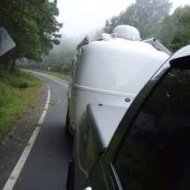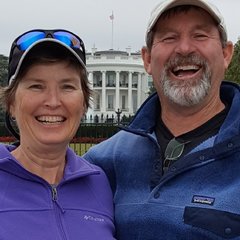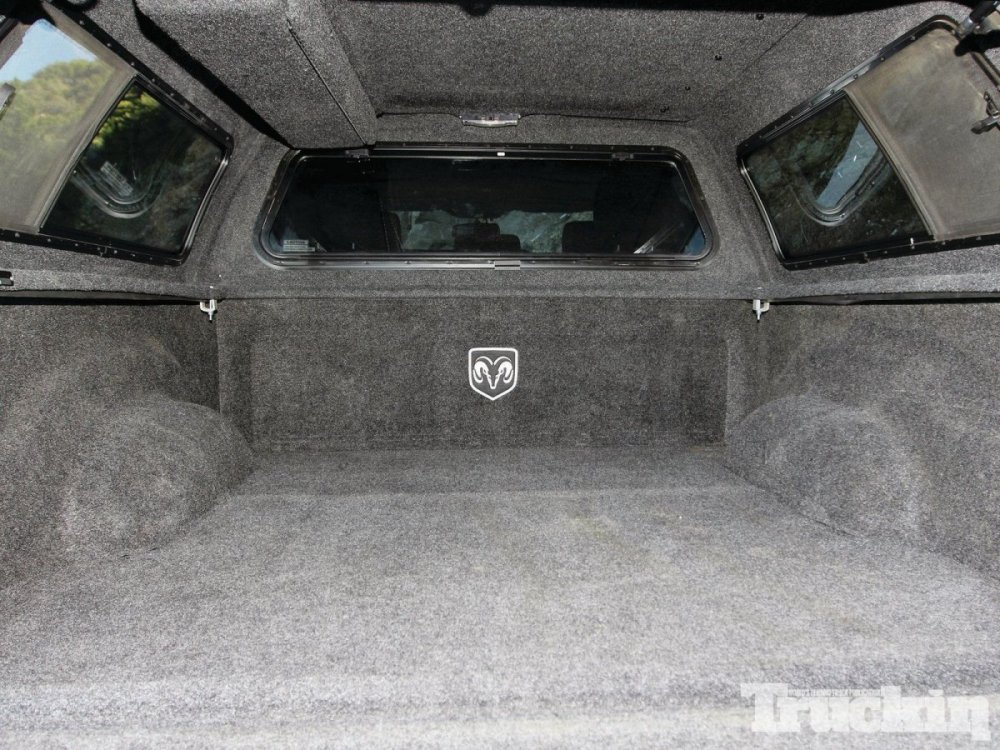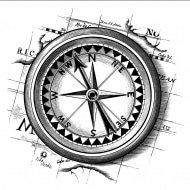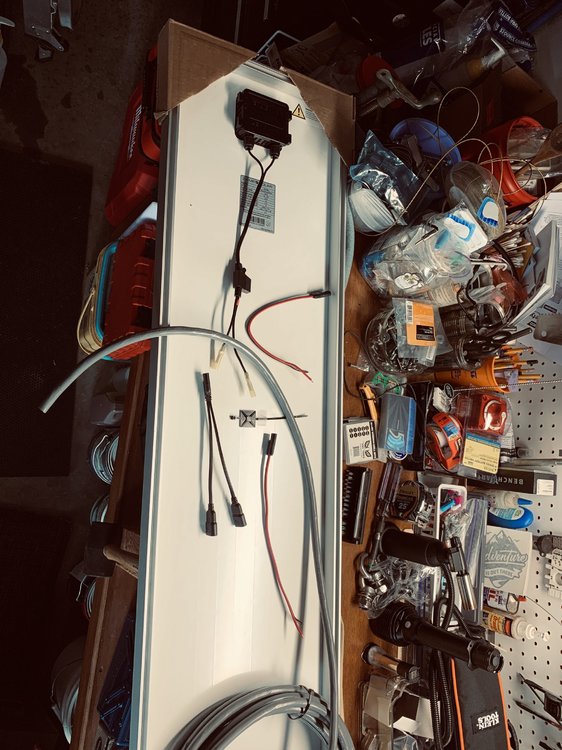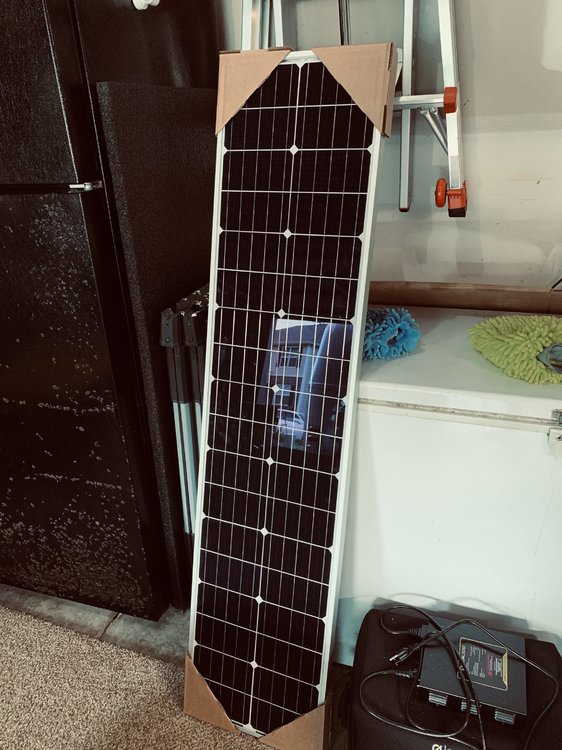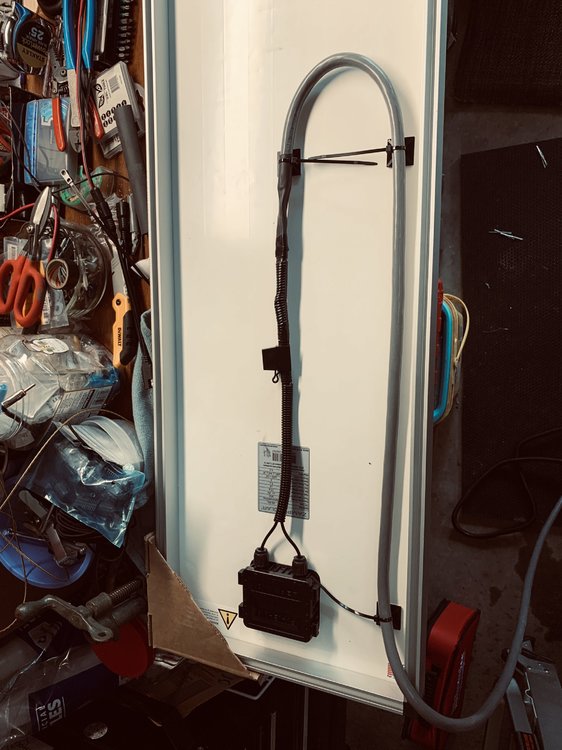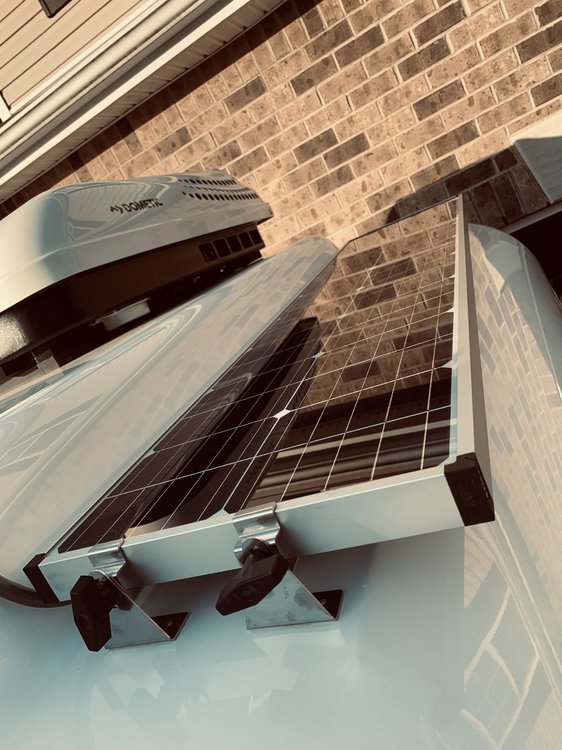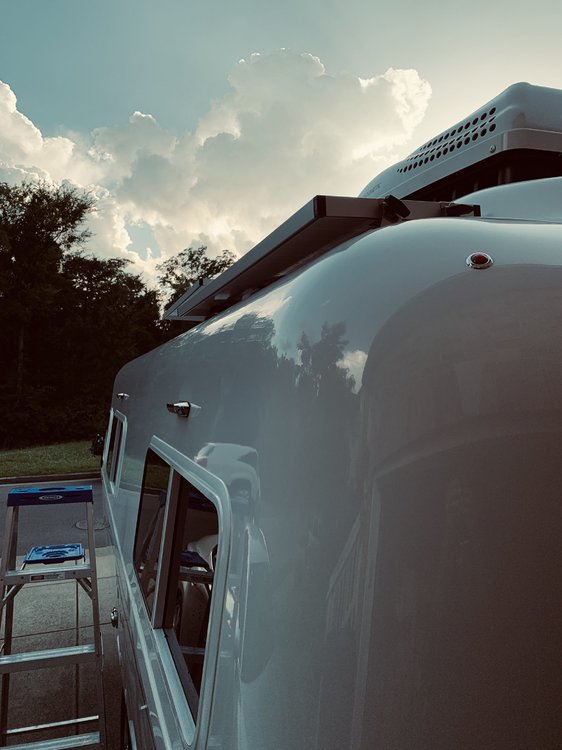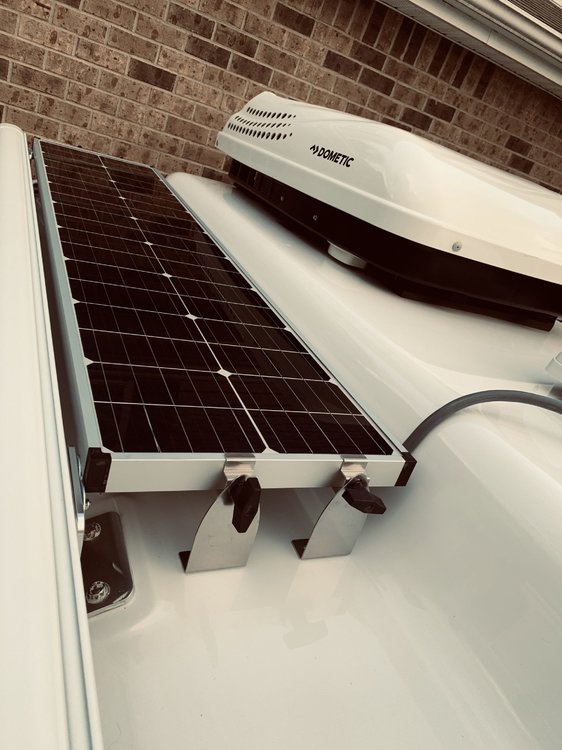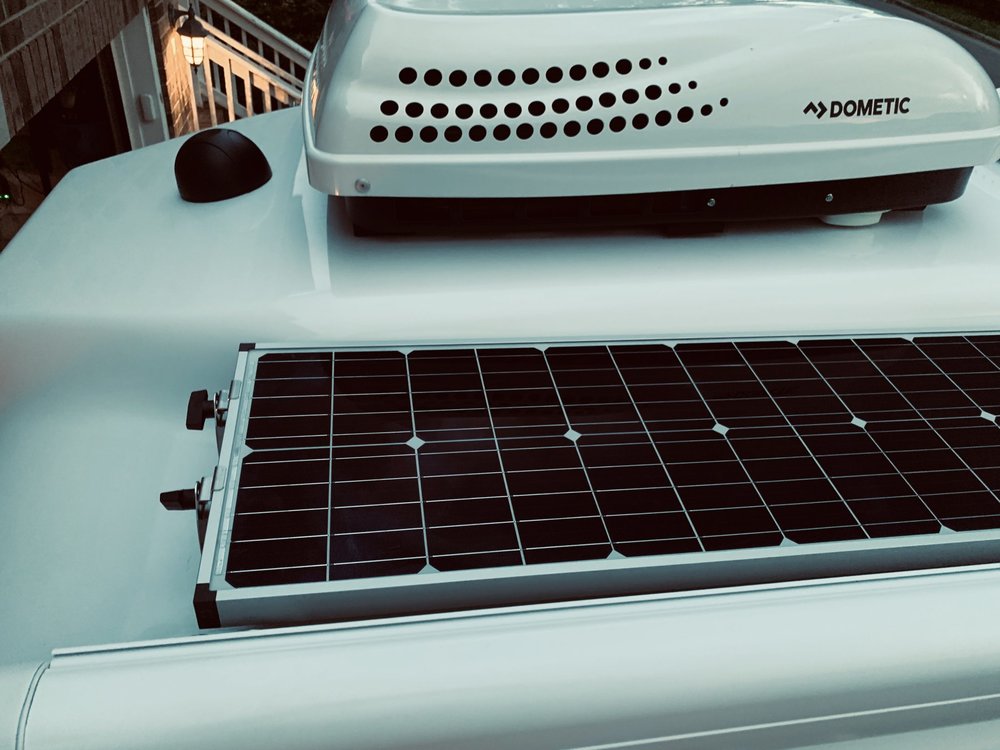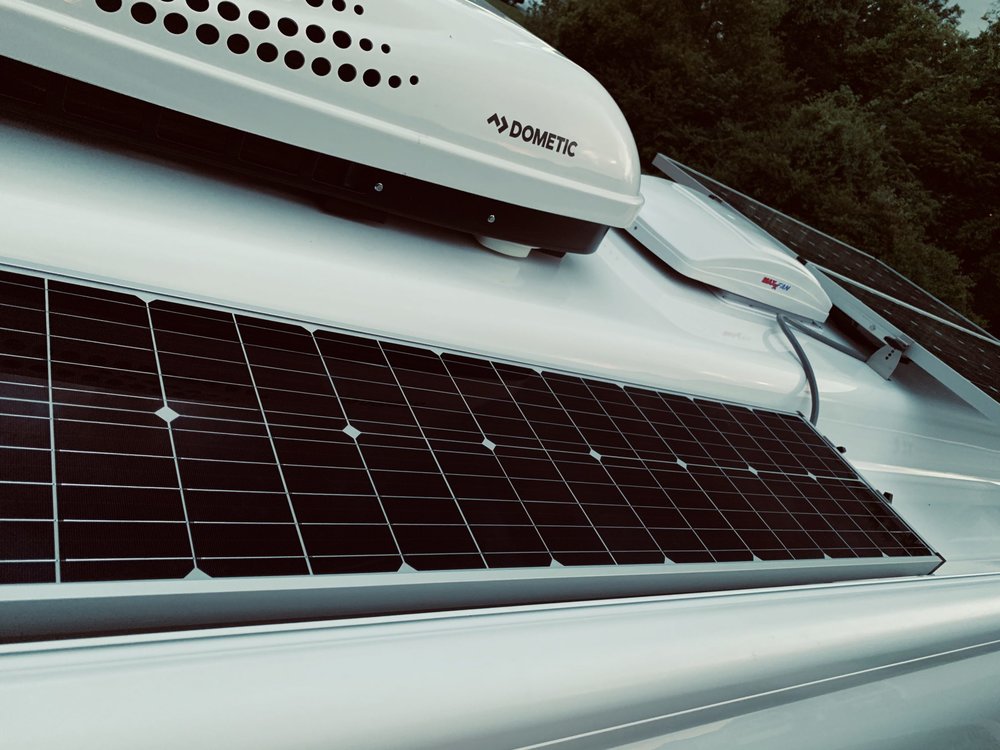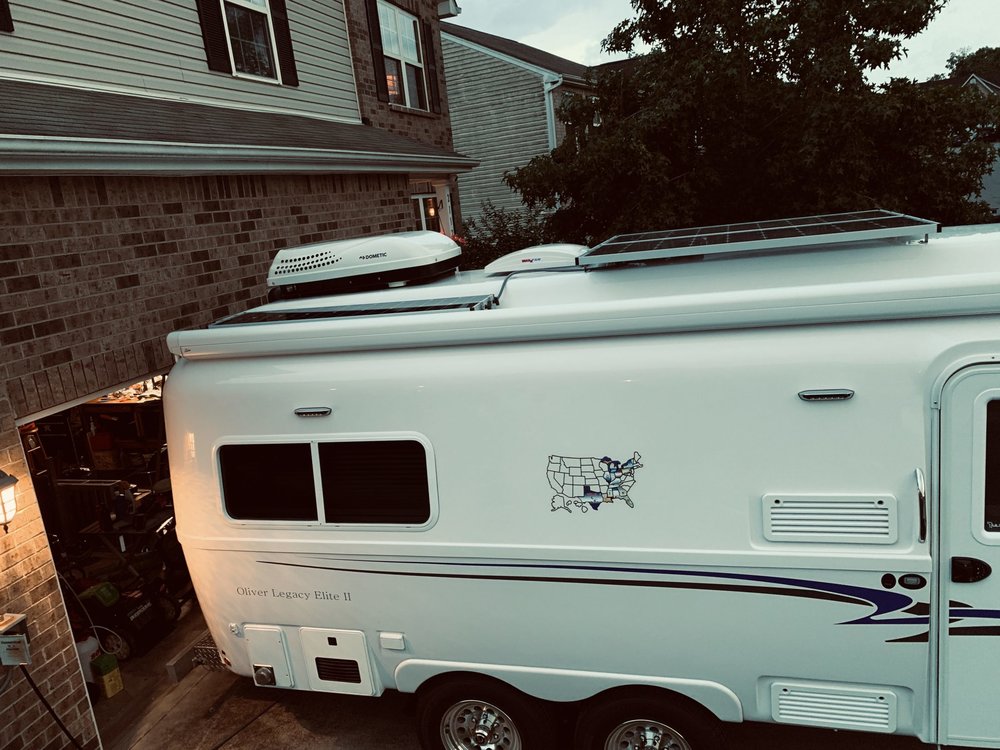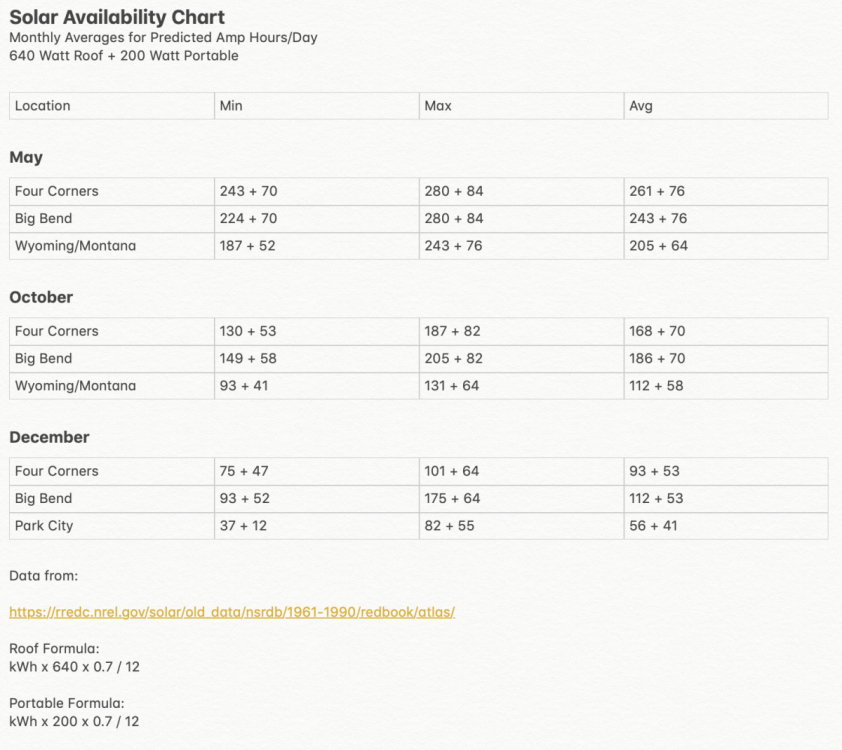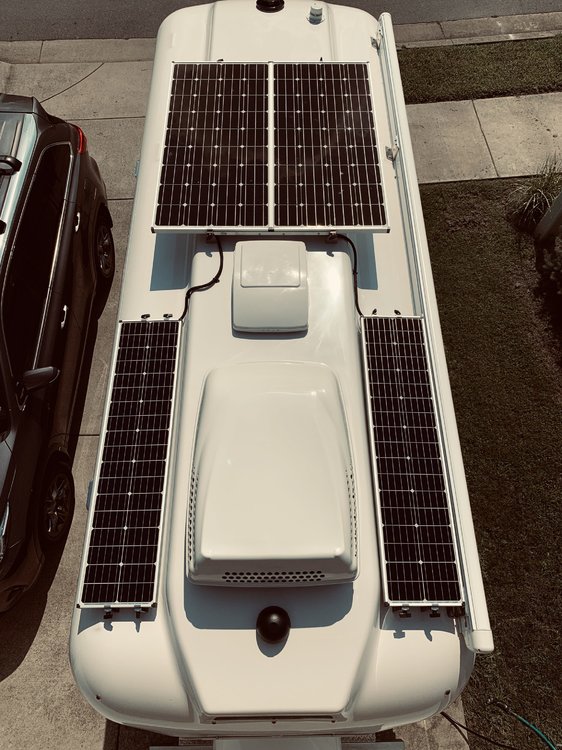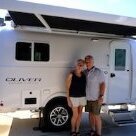Leaderboard
Popular Content
Showing content with the highest reputation on 09/08/2020 in all areas
-
There seems to be concern for the need to have heated LiFePO4 batteries. I too was concerned before I installed our Battle Born batteries. I thought about drilling holes in the compartment, to allow air to flow from the basement into the compartment and installing a heating pads. From our experience, neither have been necessary. I did seal the four holes on the battery compartment door and installed a single layer of the same insulation Oliver uses on the basement compartment door. We have camped in temperatures down to 16 degrees and exterior of the batteries have never gone below 49 degrees. Andrew4 points
-
I live close to Guntersville and I just want to let everyone know that about five miles up the road , the park has a primitive camping Site that is beautiful and I believe everyone can have lake front options. It is first come first serve. They will let you swap and it is cheaper of course. For those who love Boondocking, it is a great spot. Water available. IMG_0521.MOV3 points
-
1. RE @NCeagle's concerns about prolonged charging at 100%, I know that Battleborn batteries have a higher capacity than labeled and that their BMS is supposed to keep their batteries within a range that will prolong their life. Do you use a similar tactic or should owners be cautious about charging your batteries to 100% or depleting them to 0? I did notice that you recommend that owners deplete their batteries to 50% if being stored for longer than 30 days, whereas Battleborn recommends charging them to 100% before disconnecting. 2. Is your BMS software upgradable via your app? Are there any user controllable parameters for your BMS? Does the software provide any insight into battery health, cell balance, etc., or does it just give info on state of charge? 3. For those of us with programmable chargers, what do you recommend for absorption and float voltages, charge current, absorption time, etc.? 4. I've read that Battleborn says that the main difference between their batteries and yours is that they use a cylindrical cell vs a prismatic one. I haven't a clue about the two, but Battleborn reportedly says that in their tests the cylindrical cells lasted longer and were easier to keep balanced. What is your response to that? 5. The simplicity of these types of batteries with a built in BMS is a sword with two edges; i.e., there's more to go wrong and if it does, then you've lost the whole battery. You guys have doubled down on that by including bluetooth and heating inside the box and I'm wondering are either of those, or your BMS repairable, or worth the trouble to get repaired even if it is? Hello Overland, While I would enjoy having a discussion that compares LiFeBlue to other brands, I told Oliver TT that I would not do that on the forum. You’ve asked many questions that are answered on the website and in the data sheets. I’ll try to keep my answers brief. The data sheet is found here: http://www.lifebluebattery.com/ewExternalFiles/LB12200-HCLT Data Sheet.pdf Charging, protection The LiFeBlue BMS fully protects our battery cells. When the battery is full, It will will block all charge current coming in if any cell becomes saturated. This happens at 3.8 Volts. The charge inhibit function will latch until you begin to discharge the battery. The maximum rated voltage of our cells is 4.2V and our BMS keeps cells well under this limit. No harm happens to our battery by fully charging. Charge Profile LiFeBlue Battery BMS was designed with a broad input for voltage and current. They can be fully charged with any voltage from about 13.6V up to 16 Volts. We recommend about 14.4 Volts Absorb or CV for about 15 minutes, then reduce CV to float at 13.8 Volts. There are many other profiles that will work with out BMS. Discharging You can fully discharge (100% DoD) our battery without harming it also. Our low voltage cutoff happens when any cell group drops to 2.8V. The battery will enter sleep mode by disabling the MPU including Bluetooth. Current draw is reduced to 0.0005 Amps (5 micro-A). Storage, There are many aging studies indicating that storing an LFP battery at 100% will reduce cycle life much faster than storing at 50% or lower. Capacity retention is greater when storing at 50% SoC due primarily to increased positive electrode oxidization. Capacity We have noticed that our cell manufacturing process has increased energy density by about 5% to 10% in the last few container loads we have received. Our 300AH can have up to 330AH of stored energy. BMS firmware Our BMS can be updated only by us. The user can not access this feature with the user App. App The app has many functions. Renaming the battery is the only change you can make with the App. See the App page here: http://www.lifebluebattery.com/smart-connect-details/index.html Cells It is cheaper and faster to make a cylindrical cell than a prismatic cell. We use 25AH prismatic cells which cost more to produce than cylindrical cells. Like cylindrical cells, we use series and parallel connections but we have far fewer parts in each battery. We believe this means fewer points of failure over the life of the battery. For the last 2 decades I have done a lot of study on battery chemistries and have not seen any evidence that a LFP cylindrical cell will last longer than a prismatic cell. Let me know if you have found such a study. Our cells have actually been lab tested and with 1C discharge rate produced over 2800 cycles with 83% remaining capacity, the highest rating in the industry. Most Li batteries only claim 2000 cycles with 80% remaining. You said, “...a built in BMS is a sword with two edges; i.e., there's more to go wrong and if it does, then you've lost the whole battery.” One of our many innovative designs is that our battery is fully repairable at any time in its life cycle. If the BMS or a cell fails, even if it's many years from now, we can still repair it so you can continue use until it is spent. Currently drop in RV type Li batteries are made in China, Korea and Japan. None are made in the USA. There are many companies importing very cheap Li batteries. We choose not to go the route of cheapest price. Our goal is to have the highest quality battery that is also feature rich and the longest lasting. We have made many innovations such as our Bluetooth communications, high output BMS, low temperature batteries and so on. I hope this has addressed many of your questions.2 points
-
Hello Fritz, Statement 1 above is incorrect. With our latest BMS, if the cell temperature drops below about 26°F, the heater circuit will activate whenever you apply charge current. If the current is below 0.05C , charge current will be delivered to the cells. If above 0.05C but less than the minimum required for the heater, the battery will not charge and a 10 minute delay timer will start. When sufficient current is available, the heater will activate. When the release temperature threshold is met, current will be directed to the cells. The charge source can be anything that make 12 Volts, shore power, alternator, generator or PV solar. You can combine charge sources if needed.2 points
-
I have the Decked drawer system and love it. It is waterproof and I never am crawling/reaching for anything in the bed. Everything stays locked up and organized. For larger items, I have a Yakima rack where I can cable lock the generator on top of the Decked drawers, carry kayaks and, 2 - 4 extra gallons of gas in Rotopax cans.2 points
-
It is clear that some of you have a very strong electrical background, but I needed some refresher to better understand these lithium battery discussions. So I’m going to try and re-phrase what I’ve learned from this discussion and Oliver. And, cutting to the chase, I’m rethinking the value of the lithium pro package. Perhaps this summary will help others. Warning: long post. Electrical current can be described with this formula: Current = “I” (amps) = Power (watts) / Voltage (V) By example, the current 11,000-btu A/C draws about 1,100 watts. If plugged in to 120V shore power, the current to run the A/C is 1100W/120V, or about 9.17 amps. If, however, the A/C is run on inverted 12V power, the draw is 1100W/12V, or about 91.7 amps. Thus, an hour’s worth of battery-powered A/C would discharge the batteries by about 92 amp-hours. Actually, the discharge would be a bit greater (about 2 amp-hours), because the inverter uses about 2 amps to do its inversion. After this hour of cool air, the batteries could be recharged with shore power at 120V, solar gain at 12V, or (at least theoretically) the tow vehicle (at 12V). Several people have commented that tow vehicle provides very little charge through the standard 7-pin connector, because the wiring is too small. LifeBlue described a TV wiring modification to provide a greater charging current, but others (e.g., Overland) have questioned the ability of newer alternators to supply this current without damage. Absent TV modification, this option is out. With shore power, the controller is set by Oliver accept a charge current of 100 amps. At this rate, it would take a little less than an hour to replace the 92 amp-hour charge after using the A/C with battery power for an hour. The battery could be recharged with solar gain, but this would take substantially longer. With an average gain of about 120 amp hours (see Overland’s solar availability chart posted 6/15/20, using May Wyoming/Montana values), it would take almost a full day of charging (~120 amp-hours) to make up for an hour of battery-powered A/C use. The battery also could be charged with a generator to replace the draw of an hour’s worth of battery-powered cool air, but this, for some, might defeat the purpose. Nontheless, a 1000W generator might replace the 92 amp hours in about an hour (at 100 amps/hr), and a 2,000W generator would do this same job in about 30 minutes. (as an aside, I just checked the Honda 1000W and 2000W generators on Amazon: the 2000W unit is 10 lbs heavier than the 1000W version, slightly quieter than the 1000W unit, and only slightly more expensive. Other electrical uses are also drawing from the battery. This includes lighting (about 7 amps with everything on), electronics (camera, wifi, cell booster, tank monitor) takes about 5 amps, water heater uses about 5 amps, and both vent fans might pull up to 9.5 amps. The inverter takes about 2 amps when in “invert” mode and about 0.4 amps on standby. A composting toilet fan draws perhaps another 1-2 amps. The furnace draws electricity to run. My point is this: an average solar gain of about 10-15 amps on a moderately sunny day, with the trailer in the sun for perhaps 8 hours, will be just enough (or maybe not quite enough) to make up for regular daily uses. There’s not much solar gain left over to recharge from battery-powered A/C use. Similarly, on a series of cloudy days in (as is common in the Pacific Northwest), or when parked in shade, the solar alone could be insufficient for even basic uses over a period of time. Question: does this reflect your experience? So now I get it: this is the reason that folks carry generators (which I’ve always avoided). My hope for the lithium pro solar package was that it would reduce the need for a generator, and perhaps provide the occasional 30-60 minutes of A/C during a hot rest area break. But without generator or shore power (or modified TV power), it’s hard to see how the solar system will keep up with even occasional A/C use. It seems that after spending a premium for lithium pro system, the weakest link could be the solar charging capacity (i.e., need more panels). And if a person is going to carry a generator anyway, might not the 2000W inverter and AGMs be sufficient? Thoughts, anyone?2 points
-
Hello all. I've been on a quest to buy a used trailer for several months. Unlike many, I plan to live in it year-round, so 4-season ability is a must. I am single, so I think something 16-20 feet would be sufficient. Until recently, I thought I would be buying an Escape, but the insulation in those seems much less than on the Olivers. I don't need a lot of bells and whistles, like A/C, power awnings, electronic stabilizer jacks and a tv, but it seems like I can't escape those features with Olivers. Basically, I need a sturdy trailer with good storage, great insulation, ventilation and the option of a urine diverting toilet, like a Nature's Head. For now, I'll keep my eye out for an Elite I for sale that is closer to Oregon than Tennessee or Florida. Something west of the Rockies would probably be easier/cheaper to purchase. If you have any suggestions, like what year models of Elites I should focus on, classifieds off this site that you recommend or any other general advice, I'd much appreciate it. This is a big purchase for me and your experienced help is valuable and appreciated. Cheers, Daniel1 point
-
One feature of my 2008 Elite, "The Wonder Egg", that is no longer available in later models is the 45 foot long 30Amp service cable on an electric reel. It occupies the space under the front dinette seat which now contains the furnace on newer models. It is one of my favorite features and I would sorely miss it if I ever bought a newer model . . . which is NOT likely to happen . . . ever . . . I LOVE The Wonder Egg!1 point
-
This has been an enlightening thread. The lithium option looks promising. I’m left scratching my head a little though on the cost vs benefit. We boondock about 50% of the time. The other 50% we have 30a. My AGMs have performed well and I barely look at them once a year. We have covered storage with a 20a that I plug in to. Temps here range from about 25 to 105 degrees and I’ve never thought about cooling or warming them. Like I said, I’m scratching my head a little.... Mike1 point
-
While you’re in Hohenwald, stop by the Tractor Supply and see if they have any Champion inverter generators. At our Tractor Supply here in Boerne I got a 2K Watt, 37 lbs, very quiet for $349 on sale. It has performed flawlessly the last couple of years and is as quiet as the Honda or any of the inverter generators.1 point
-
I'm planning on just using the package price to keep it simple. I don't know any better and Oliver has been nice enough to call it a "Solar Package". 🙂1 point
-
OK. Here's a fact from our business over many years: No customers has ever told us that they could not use the credit because the alternator or generator or shore power also charge the batteries. Customers wrote to thank us for the ITC info. They had never heard of it. They all used the full amount for the credit and were grateful for the $ thousands saved. I understand your wanting to research so I hope this is helpful.1 point
-
Actually, it makes no sense to me whatsoever to try and prorate something that you haven't even used yet!! 😏 But we are talking about the federal government! Trust your tax advisor of course. Based on what I know from research and what Larry said about what other customers do, I will be taking the credit for the entire package. Here's a good summary that is in line with other things I've read... https://www.wholesalesolar.com/solar-information/federal-tax-credit#:~:text=Solar Tax Credit History&text=As of January 1%2C 2020,your solar system%2C including installation.1 point
-
Nope, sorry for the misunderstanding. Our Oliver did not come with any pin at all, probably got left out by mistake, but we have been using a long neck master lock similar to what you would use for a Yeti Cooler which works great plus its an additional security lock also.1 point
-
That is great information. Stuff like that should be on your website! Seriously consider hiring a web developer and adding more technical information. The current site made me seriously consider how I might spend $4,000 elsewhere. 🤪 A lot of the early battery management systems would actually kill lifepo4; parasitic drain from WiFi, Bluetooth, LEDs, etc. I really appreciate you taking the time to answer most of these questions.1 point
-
That is correct. Up to 10A per battery will bypass the heater circuit. That means with PV solar power, you can be charging in early morning, not wasting the power. If current rises above the threshold, the battery will stop charging and turn on the heater circuit. Each battery requires 12 Amps to turn on the heater. If your PV solar can not produce enough current, the battery heater timer will start. You are also correct, there may be a period where the battery heater will not be on but the current is too high to charge the cells. This is another reason I recommend installing the auxiliary charge circuit from the alternator. Of course, a generator of shower power can also be used and the heaters will turn on.1 point
-
Hello AndrewK, This is true. It is the internal temperature that matters. Just using the battery provides some internal heating that helps replace heat loss with cold ambient temperatures.1 point
-
1 point
-
One important note: some of the batteries mentioned in this thread do not have low temperature protection.1 point
-
LifeBlue's data sheet shows the heater coming on at 32°, which is more reasonable than what Oliver said. I think some clarification from @LiFeBlueBattery would be helpful regarding the need for a 120v connection when charging in the cold. I'm not really sure how that even works, I guess that the heat pack in the battery requires a certain number of amps before it will engage? Regardless, the inability to charge via solar in cold weather seems like it would be a significant limitation. Also some guidance on storage temps would be appreciated. If owners can feel safe with what Topband recommends (3 months at 113°), then I'd think that people shouldn't worry too much about it. If 95° is really the limit though, I think that people would be concerned about their warranty and the lifespan of the batteries.1 point
-
I'm not sure where the 95F number on Lifeblue's datasheet comes from other than Topband's optimal storage conditions. If you look at the real data sheet it states: Storage Environment: < 1 Month: -20~+60℃,5~75%RH < 3 Months: -10~+45℃,5~75%RH Recommended Environment: 15~35℃,5~75%RH Charge and discharge temps: Charge: 0~45℃ Discharge: -20~60℃ Source: http://www.rechargeablelifepo4battery.com/sale-11854400-bluetooth-app-12v-200ah-lithium-iron-phosphate-battery-customize-with-heating-film.html1 point
-
Overland may have been one of the last to get that kind of customization. You could ask your sales rep if service would install after pickup. Some owners have added and upgraded solar om their own. Here's a link to Rideaceuces upgrade:1 point
-
1 point
-
MaryRN - Thanks for the info! You wouldn't happen to have either GPS coordinates and/or move specific directions? Bill1 point
-
Well summarized Susan. These are the reasons I'm investing in lithium - I'm certainly not investing in the technology hoping to run my A/C all night while boondocking. The reasons are really convenience (more forgiving) and cost savings over time when compared to the AGM / wet batteries. I've already conceded trying to get rid of my generator - it's not going to happen any time soon. Also, I definitely would not have gone with the Lithium package if Oliver had chosen the non-heated version.1 point
-
Probably need a oversize permit to run that thing down the road.1 point
-
Good point. A bad fan was my initial thought. The set point on thermostatic switch must be pretty high though. I only notice it coming on if the batteries are down a bit after a long run, and when the temperature inside the trailer hasn't yet cooled down. The odor can occur whether the fan comes on or not.1 point
-
My experience is that we can get by fine without a generator, but then we don't camp in hot weather. If we know that we're going to need the AC at night, then we plan to stay at a campground with hookups. For occasional use, like the 30 minutes to an hour for a lunch stop, we do OK. We typically will run the AC for about 5 or 10 minutes and that cools the trailer down sufficiently to enjoy lunch. We'd rather eat without the racket of the AC anyway.1 point
-
It does seem that the LifeBlue batteries have a narrower operating range than my Battleborns. Their recommended operating range is 24° to 135°. Actually, 24° is the temperature at which their BMS will cut off charging, as measured within the battery. So conceivably, the outside temperature could dip below that, since it would take a while for the batteries themselves to reach that temperature. To my knowledge, Battleborn doesn't have a recommended storage range, but I do know that Victron recommends -49° to 158° for their batteries, and they are generally pretty conservative with their numbers. Battleborn doesn't require you to discharge their batteries before storage. They do recommend disconnecting any trickle charge (solar).1 point
-
1 point
-
Lithium Batteries in Cold Weather There seem to be 2 threads on this lithium battery topic (this thread and the one called "LifeBlue Battery Representative." Dean and I posted some questions about battery heating on 8/27 in the latter thread that went unanswered, but I received some relevant information from Oliver that I thought I'd share. This thread seemed like the better place to post. The LifeBlue batteries require heating when charging at less than 37°F. The only way to charge them at temperatures less than 37°F is with 120 V shore power (or perhaps generator). Shore power is first used to heat the batteries, and then to charge the batteries. The batteries can provide electricity at temperatures less than 37°F, but they won't accept a solar charge. According to Oliver, LifeBlue recommends that their lithium batteries be discharged to about 50% when stored for an extended period of time. Oliver has included a solar cut off switch to turn off solar gains, so that the batteries can be discharged to 50% without solar gain. In the mountain west, temperatures can go below zero in the winter and above 100°F in the summer. According to Oliver, all batteries can suffer the effects of excessive heat. One way of protecting the batteries during storage would be to remove them from the trailer and store them in a more suitable environment. This would also allow checking internal temperatures and charge level. They would be lighter than other batteries, making them easier to remove and transport.1 point
-
1 point
-
ScubaRX ill be at your table for the high class junk should be good stuff.🛠⛓🔩🗝🔌📡1 point
-
Surely the most regrettable change in the Elites was when they removed the stripper pole. 😝1 point
-
1 point
-
+1 on the quality of Foy's work. Both items make the Oliver's interior look even richer. As a side note, my wife and I tend to shower before going to bed. We place the shower mat outside the shower and replace it when we're done. This prevents either of us risking wet feet when we get up during the night to use the bathroom.1 point
-
Welcome to the forum. You are correct about your older Tundra..... the 4.7 is a great motor but it is pretty anemic for pulling the bigger Ollie, and the lack of gears makes it worse. You would probably be fine getting your new trailer home to Florida at delivery time but further explorations will require better reserves of, well, everything - power, brakes, payload and safety technology. John Davies Spokane WA1 point
-
1 point
-
1 point
-
Hi Jim and Deb, welcome to the forum. Like Bill, I recommend a factory as well. We’ve done it a couple of times and we still learn things. Also, there will be a bunch of Olivers at Lake Guntersville State Park in Alabama the end of September. It was going to be our annual rally but was canceled due to the virus. Some of us are still planning to be there because we enjoy camping! Mike1 point
-
Certainly you pick a delightful couple to have them show you the Ollie. If you ever get the chance, be sure to take the factory tour. There you will see the detail of how they are made which makes the finished product even more impressive. Let us know if you have any questions and enjoy this new journey you have embarked on. Bill1 point
-
Finally got around to installing the Zamp 90 watt slender panels on the Oliver today. Very simple, just some heat shrink for the wire connections and putting the feet on the panels. I used the AmvSolar tall feet on the passenger side and the standard ones on the driver side and prepped with alcohol before applying the supplied VHB tape... seems to be very sturdy. Time will tell. Still have to tidy up the wires but a thunderstorm with lightning rolled in. The package Am Solar sells had everything included for the install except (2) Zamp SAE connections and a SAE Y-splitter. But they sell both on the website. For some reason they cut off the original SAE connector so you have to re-install one, maybe if you gave them advanced notice you could get one that has not been removed. Curious to see how much Amp hour difference stored tomorrow. From Am Solar: My install:1 point
-
This is the chart I made for our system. Divide by 2 for a typical Ollie setup: So, yeah. Realistically, if we're talking 300Ah of batteries and people people freak when their batteries hit 50%, we're talking about an hour and a half of AC use. In most situations, once you include your other uses, the average Ollie owner could plan on the better part of two days of sunlight to recoup that. Average - if it's truly mid summer, four corners, zero clouds, you could possibly get it back in a day. If it's cloudy, might be three. I've said many times - it's not magic. AC units have tremendous appetites and solar output is one of the most exaggerated topics in the RV world, both from dealers and owners. Solar is great, LFP is great, but there's a reason my trailer looks like an aircraft carrier.1 point
-
1 point
-
Recent Achievements








